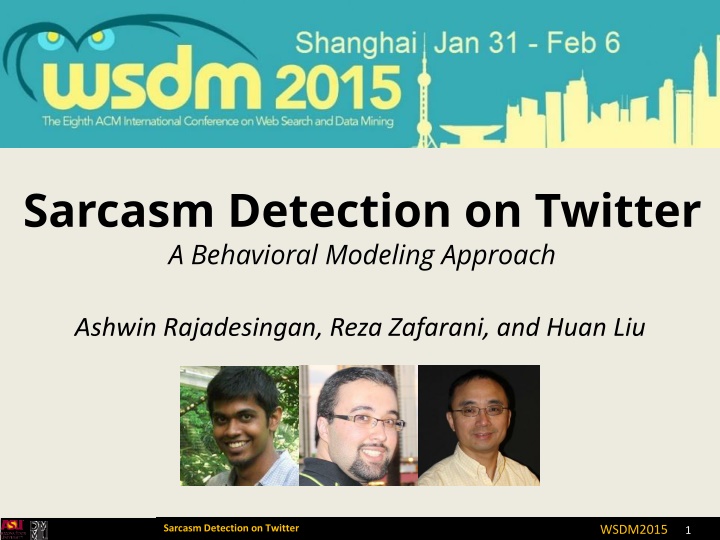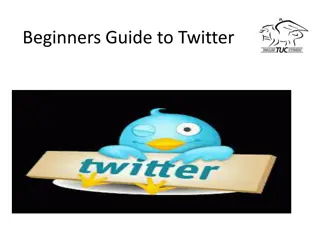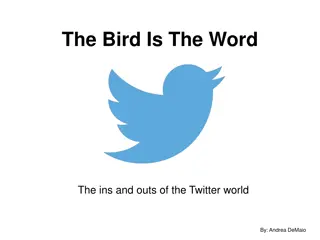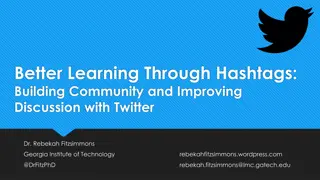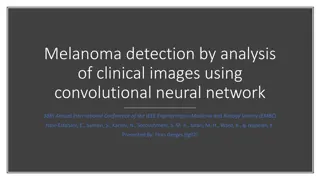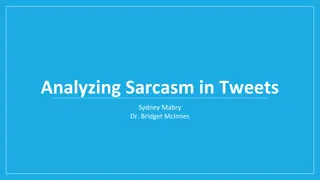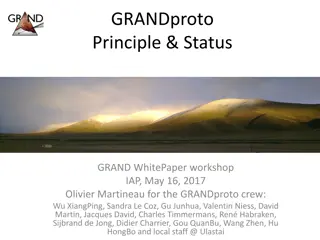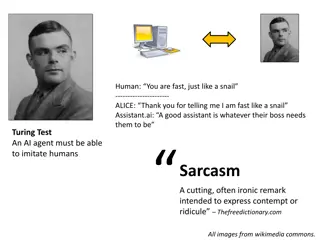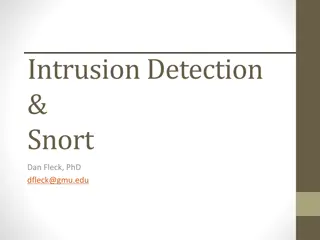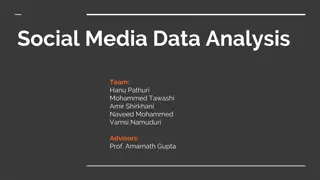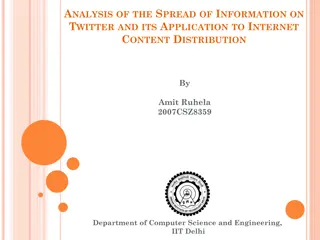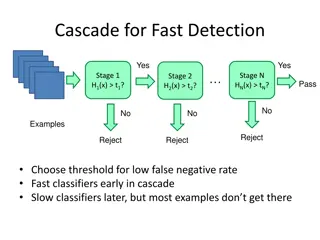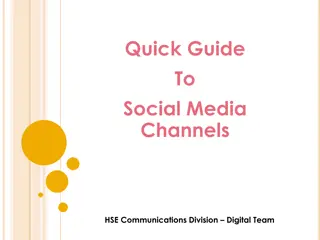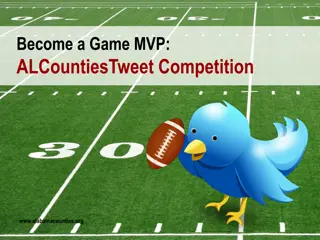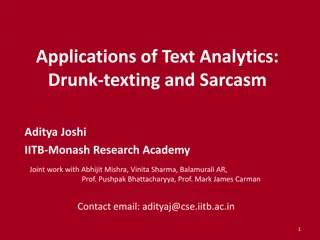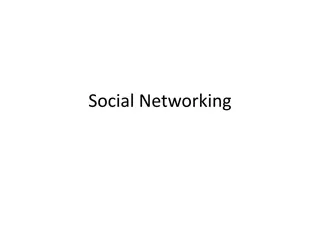Sarcasm Detection on Twitter
This study presents a behavioral modeling approach for detecting sarcasm on Twitter. The research conducted by Ashwin Rajadesingan, Reza Zafarani, and Huan Liu is focused on developing a model to effectively identify and interpret sarcastic tweets within the platform. The methodology aims to enhance the understanding of sarcasm in social media contexts, particularly on Twitter, through incorporating behavioral patterns and linguistic cues. By leveraging these insights, the model contributes to the advancement of sentiment analysis and natural language processing techniques in detecting sarcasm in online communication.
Download Presentation

Please find below an Image/Link to download the presentation.
The content on the website is provided AS IS for your information and personal use only. It may not be sold, licensed, or shared on other websites without obtaining consent from the author.If you encounter any issues during the download, it is possible that the publisher has removed the file from their server.
You are allowed to download the files provided on this website for personal or commercial use, subject to the condition that they are used lawfully. All files are the property of their respective owners.
The content on the website is provided AS IS for your information and personal use only. It may not be sold, licensed, or shared on other websites without obtaining consent from the author.
E N D
Presentation Transcript
Sarcasm Detection on Twitter A Behavioral Modeling Approach Ashwin Rajadesingan, Reza Zafarani, and Huan Liu Sarcasm Detection on Twitter WSDM2015 1
Sarcasm a nuanced form of language where usually, the user explicitly states the opposite of what she implies. Sarcasm Detection on Twitter WSDM2015 2
Why Detect Sarcasm? Most large companies have dedicated social media teams providing real-time assistance to consumers. These teams use social media tools such as Salesforce s Social Hub to manage the high volume, high velocity tweets. One Reason is to Avoid PR Blunders Sarcasm Detection on Twitter WSDM2015 3
Related Work Authors Conference EMNLP 2013 Overview of methodology Lexicon-based approach contrasting positive sentiment and negative situation Riloff et al. Liebrecht et al. WASSA (ACL 2013 workshop) Unigram, bigram and trigram features used to train a Balanced Winnow classifier Reyes et al. DKE 2012 Ambiguity, emotional cues etc., to train decision trees Gonzalez-Ibanez et al. ACL 2011 lexical and pragmatic features to train SMO classifier Davidov et al. Tsur et al. CoNLL 2010 ICWSM 2010 Patterns and punctuations based features used in a weighted k-nearest neighbor classifier Viewing sarcasm from a linguistic perspective Sarcasm Detection on Twitter WSDM2015 4
Some Characteristics of Twitter Fewer word cues (140 character limit) Evolving slang words, abbreviations, etc. However, Twitter provides Past tweets Profile information Social graph Sarcasm Detection on Twitter WSDM2015 5
Problem Definition Given an unlabeled tweet t from user u along with a set of u's past tweets T, a solution to sarcasm detection aims to automatically detect if t is sarcastic or not. Sarcasm Detection on Twitter WSDM2015 6
SCUBA ( Sarcasm Classification using a Behavioral modeling Approach ) SCUBA learns from findings of behavioral and psychological aspects of sarcasm to determine if a tweet is sarcastic SCUBA captures these behavioral patterns in users past tweets and profiles to complement the (relatively little) information available in tweets SCUBA constructs computational features to train a supervised model to detect sarcastic tweets Sarcasm Detection on Twitter WSDM2015 7
1. Sarcasm as a Contrast of Sentiment (Grice, 1975) a. Contrasting Connotations Using words with contrasting connotations within the same tweet. Difference between the maximum positive and negative sentiment/affect words present as features. b. Contrasting Present with Past Sarcasm Detection on Twitter WSDM2015 8
2. Sarcasm as a Complex form of Expression (Rockwell, 2007) Readability Features inspired from tests measuring readability of text Measures Readability Test Number of words and syllables Flesch-Kincaid Grade Level Formula Number of polysyllables SMOG test Average word length Automated Readability Index Sarcasm Detection on Twitter WSDM2015 9
3. Sarcasm as a Means for Conveying Emotion (Basavanna, 2000), (Toplak, 2000), (Ducharme, 1994), (Grice, 1978) a. Mood: A user in a foul mood is more likely to use sarcasm b. Emotional expressiveness: how expressive a Twitter user is based on past sentiment usage c. Frustration: People use sarcasm to vent out frustration (Ducharme, 1994) - number of swear words Sarcasm Detection on Twitter WSDM2015 10
4. Sarcasm as a Function of Familiarity (Cheang, 2011; Rockwell,2003, 2011) a. Familiarity of environment People express sarcasm better when they are well acquainted with the environment. We can model it with features such as: Number of tweets posted in Twitter Number of friends and followers Frequency of Twitter usage b. Familiarity of language (Dress, 2008) Measured with vocabulary/grammar skills We measure vocabulary and POS usage in Tweets Sarcasm Detection on Twitter WSDM2015 11
5. Sarcasm as a Form of Written Expression Sarcasm in speech includes low pitch, high intensity and a slow tempo (Rockwell, 2000). Written sarcasm is devoid of such options. a. Prosodic variations a. Structural variations: Structural variations are inadvertent variations in the POS composition of tweets to express sarcasm. Sarcasm Detection on Twitter WSDM2015 12
Research Questions 1. Does our behavior modeling approach work? How well? 2.Does using historical information actually benefit sarcasm detection? If so, how much historical information is required? 3.Which features from theories contribute most to sarcasm detection on Twitter? Sarcasm Detection on Twitter WSDM2015 13
Dataset Sarcastic tweets: 9,104 tweets containing #sarcasm and #not Other tweets: 81,936 random sample of tweets (after removing tweets containing #sarcasm and #not) Dataset: http://bit.ly/SarcasmDetectionWSDM2015 Sarcasm Detection on Twitter WSDM2015 14
Baselines Contrast Approach -tweet is sarcastic if it contains a positive verb phrase or positive predicative expression and a negative situation phrase (Riloff et al., EMNLP 2013) Hybrid Approach - Contrast Approach +n- gram model (Riloff et al., EMNLP 2013) Embedded results from the n-gram model into SCUBA as well. We call the n-gram augmented framework, SCUBA++ Sarcasm Detection on Twitter WSDM2015 15
Baseline Algorithms SCUBA {past sarcasm hashtags feature} Majority classifier N-gram model used in Hybrid Approach and SCUBA++ Sarcasm Detection on Twitter WSDM2015 16
Performance Comparison 10-Fold Cross Validation Technique Dataset Distribution 1:1 20:80 10:90 Accuracy AUC Accuracy AUC Accuracy AUC SCUBA++ 86.08 0.86 89.81 0.80 92.94 0.70 SCUBA 83.46 0.83 88.10 0.76 92.24 0.60 SCUBA - #sarcasm 83.41 0.83 87.53 0.74 91.87 0.63 Baseline: Contrast Approach 56.50 0.56 78.98 0.57 86.59 0.57 Baseline: Hybrid Approach 77.26 0.77 78.40 0.75 83.87 0.67 Baseline: N-gram Classifier 78.56 0.78 81.63 0.76 87.89 0.65 Baseline: Majority Classifier 50.00 0.50 80.00 0.50 90.00 0.50 Sarcasm Detection on Twitter WSDM2015 17
Can historical information improve sarcasm detection? SCUBA without historical data: 79.38% accuracy Outperforms all other approaches Historical Data Helps 4.14% increase in performance. 30 tweets seem sufficient Sarcasm Detection on Twitter WSDM2015 18
Which Forms Contribute most to Sarcasm Detection Feature set Accuracy All feature sets 83.46% - Contrast-based features 57.34% - Complexity-based features 73.00% - Emotion expression-based features 71.52% - Familiarity-based features 73.67% - Written expression-based features 76.72% Sarcasm Detection on Twitter WSDM2015 19
What Features Contribute Most to Sarcasm Detection Percentage of emoticons and adjectives in a tweet Percentage of past words with sentiment score 2,3,-3 Number of polysyllables per word in a tweet Lexical density of a tweet Number of past sarcastic tweets posted Percentage of positive to negative sentiment transitions made by a user Percentage of capitalized hashtags in a tweet Sarcasm Detection on Twitter WSDM2015 20
Summary A behavioral Modeling framework of identifying different forms of online sarcasm as: a contrast of sentiments a complex form of expression a means of conveying emotion a function of familiarity, and a form of written expression Modeled on Twitter to build a supervised learning algorithm to detect sarcastic tweets Experiments demonstrate that SCUBA is effective in detecting sarcastic tweets Sarcasm Detection on Twitter WSDM2015 21
Future Work How does a user s social network influences her propensity to use sarcasm? Does the strength of social ties matter in generating sarcasm? Can SCUBA be extended to other social networking sites? Sarcasm Detection on Twitter WSDM2015 22
